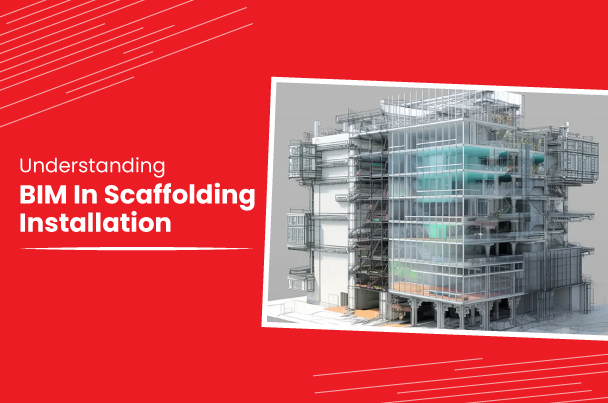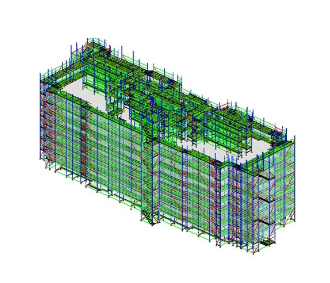
When you’re visualizing a construction project, everything may just fit together according to your plan. But, with time, Building Information Modeling (BIM) has truly transformed the ways in which construction projects can be executed. Risks related to safety can certainly be reduced through the 3D models and detailed simulations. In contrast, if the team erects the scaffold soon after it is presented on paper, then workers will certainly be worried about safety. So, in this article, we will cover more about BIM in scaffolding.
What is BIM? A Quick Overview
Building Information Modeling (BIM) is known to be a technology that enables professionals to create a 3D model. Moreover, when you go through the salient features of an advanced BIM software, it includes the costs related to construction sequencing. Individuals can also manage documents and collaborate with one another across the project’s lifecycle. Once everyone is involved in how the site or structure will look, then it can help teams in numerous ways. Besides exploring design options, the software is capable of developing visualizations. Improvements can further be made when the digital versions are in place.
If you have not understood what a BIM is all about, then take a look at the following image.

The Role of BIM in Scaffolding Installation
While you and your team members are creating a 3D model, it can play a significant role in scaffolding installation. A virtual model can serve as a blueprint to figure out an efficient way of constructing the scaffold. Centralized data management, on the other hand, can help to improve planning and reduce errors. BIM can further help to find out safety hazards and analyze them. Most importantly, diverse teams can collaborate to improve the model using a common interface or an environment.
Benefits of BIM in Scaffolding Installation
Building Information Modeling (BIM) offers many benefits when a scaffold has to be installed. The model enhances safety and collaboration and makes the implementation process smoother. So, let’s check out the benefits of using BIM.
Improves Design Accuracy
BIM enables professionals to develop a highly detailed scaffolding model. People gather together to create such models before the workers commence with installation. This reduces the risk of errors in dimensions. A visual representation also ensures that the scaffold is installed within the intended space.
Helps to plan and schedule efficiently
With BIM, workers can align the planning of installation with the project timeline. The individuals can also keep track of materials needed for the temporary structure. Moreover, they can order the right quantity of material and reduce waste.
Aids to manage associated costs
Once the model is presented, it helps to estimate the costs upfront. This can further mitigate bearing unexpected costs with precise budget forecasts. Post optimizing the installation process, BIM can also help in reducing use of materials.
Real-Time Updates
If any alterations are made in the scaffold’s design, then they can be updated instantly in the model. This reduces confusion when all parties can glimpse through the latest information and the same type of data.
Mitigates Risks
Soon after viewing the 3D model from different angles, professionals can identify the issues and resolve them. This, in turn, can minimize structural failures when scaffold maintenance is carried out.
How does BIM Facilitate Collaboration in Scaffolding Projects?
When a BIM plan is implemented, it can facilitate collaboration in scaffolding projects through a centralized platform. Once the digital version of the scaffolding project is ready, professionals can collectively discuss and make modifications. This can eliminate conflict in thoughts that may arise during the construction phases. As the 3D model can be shared, everyone can comprehend the design at their own pace. Thus, the model can help enhance cooperation and enhance the project’s quality. While viewing the model, individuals can also make modifications in real-time and notify others. On-site conflicts can thereby be reduced when the changes are informed in advance.
Steps to Implement BIM in Your Scaffolding Projects
When a BIM has to be implemented, it can be a bit overwhelming. But, the entire process will be smooth when you follow certain steps.
Define your goals
Before you implement BIM in scaffolding projects, you have to first define your goals. While you figure out the purpose of developing a model, you must know what you want to accomplish. This can reduce errors and enhance efficiency when the project is executed.
Form an implementation team
Next, you have to form a team of experienced professionals to implement BIM. These can include contractors, engineers, and BIM specialists. But, before choosing them, you must ensure that they have the skills to implement the technology.
Develop a plan
Moving ahead, you will need to prepare a document that represents the details of the implementation plan. Such a plan must cover the scope, standards, and goals in detail. It should also include the software that will be used for developing the model.
Spend time training the team
Even before you start implementing BIM, it’s important to train the team. As you make everyone familiar with the software, the professionals must also know how to use it effectively. In addition, the training must cover more about the software and hardware requirements.
After following the above process, you must test the software by starting with small-scale projects. As everyone is confident in using the software, professionals can start creating models of what needs to be erected in reality.
Future Trends: The Evolution of BIM in Scaffolding
With time, the evolution of BIM in scaffolding is soon going to transform the construction domain. Augmented Reality (AR) will enhance the visualization of the scaffolding designs. But, when training has to be delivered to the entire crew, Virtual Reality and simulations can help teams practice procedures related to disassembly and assembly. Organizations will also embrace cloud-based platforms for effective real-time collaboration. Way ahead, advanced BIM tools will also be used to estimate the amount of materials that are needed. This will help generate the procurement list with the necessary components.
Conclusion: Embracing BIM for Safer and Smarter Scaffolding
Finally, we suggest you implement BIM to figure out how you can develop a scaffold that will be safe to use. Once teams can visualize the 3D model, it can help to find out issues and evaluate structural integrity. You can also minimize risks during the assembling phase and find out how the scaffold can interfere with other components. Scaffold inspection can also be conducted with the integration of BIM.
If you’re still seeking supreme-quality scaffolding parts in the USA, then why not choose Scaffolds Supply? As you browse through the components on our official website, we assure you that you’ll seek the right parts for the scaffold. These are also designed by our team with safety standards in mind.











Comments are closed